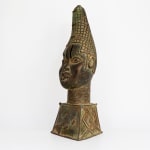Benin-Style Head of a Queen-Mother (Iyoba), Twentieth Century AD
Bronze
55 x 15.5 x 22 cm
21 5/8 x 6 1/8 x 8 5/8 in
21 5/8 x 6 1/8 x 8 5/8 in
CC.14
Further images
-
(View a larger image of thumbnail 1
)

-
(View a larger image of thumbnail 2
)

-
(View a larger image of thumbnail 3
)

-
(View a larger image of thumbnail 4
)

-
(View a larger image of thumbnail 5
)

-
(View a larger image of thumbnail 6
)

-
(View a larger image of thumbnail 7
)

-
(View a larger image of thumbnail 8
)

-
(View a larger image of thumbnail 9
)

-
(View a larger image of thumbnail 10
)

-
(View a larger image of thumbnail 11
)

It was not until the British expedition of 1897 that the artwork of Benin became known to the Western World, but Benin metalworkers had for centuries before then created some...
It was not until the British expedition of 1897 that the artwork of Benin became known to the Western World, but Benin metalworkers had for centuries before then created some of the most spectacular artworks to come from Sub-Saharan Africa. Most noteworthy among them are the so-called Benin heads, busts cast in bronze and placed on altars to venerate past oba (kings) and iyoba (queen-mothers).
This particular example depicts the latter. She wears the traditional ‘Chicken beak’ hairstyle, spectacularly rising from her head, covered in a latticework of coral beads known as the ukpe-okhue crown. Such headwear was only for the iyoba, and so allows us to identify her immediately. She has other marks of royalty too: scarification to her forehead, and the benign expression of a demigod. She wears numerous neck-rings to emphasize the slender length of her neck, and sits on a base depicting traditional patterns and a fish. These same signifiers are found on the Berlin example of the bust of Queen Idia from the seventeenth century (Berlin Ethnographic Museum III C 12507).
The Benin Bronzes express both power and timeless beauty. Through immortalizing their Queen Mother in durable materials, the Benin craftsmen guaranteed her memory would live on among her own people, and her fame would spread abroad. Benin art existed in this court context, where the craftsmen attached to different royal circles produced art for their masters and their masters alone. All this changed, however, when the British invaded; from then on, Benin craftsmen also made work for foreign markets.
This particular example depicts the latter. She wears the traditional ‘Chicken beak’ hairstyle, spectacularly rising from her head, covered in a latticework of coral beads known as the ukpe-okhue crown. Such headwear was only for the iyoba, and so allows us to identify her immediately. She has other marks of royalty too: scarification to her forehead, and the benign expression of a demigod. She wears numerous neck-rings to emphasize the slender length of her neck, and sits on a base depicting traditional patterns and a fish. These same signifiers are found on the Berlin example of the bust of Queen Idia from the seventeenth century (Berlin Ethnographic Museum III C 12507).
The Benin Bronzes express both power and timeless beauty. Through immortalizing their Queen Mother in durable materials, the Benin craftsmen guaranteed her memory would live on among her own people, and her fame would spread abroad. Benin art existed in this court context, where the craftsmen attached to different royal circles produced art for their masters and their masters alone. All this changed, however, when the British invaded; from then on, Benin craftsmen also made work for foreign markets.










